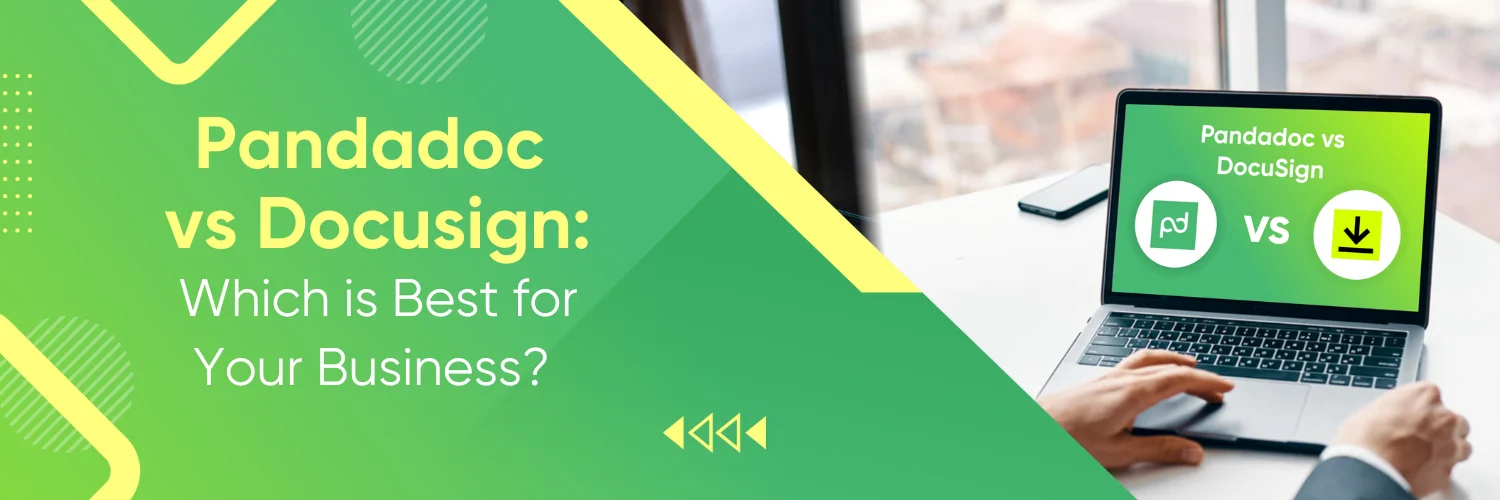E-signature solutions are essential for making processes smoother and faster. PandaDoc and DocuSign are two popular choices. PandaDoc offers more than just eSignature, including document creation and sales automation, while DocuSign is known for its strong and easy-to-use eSignature service. But how to choose between the two? Let’s find out.
What is PandaDoc?
PandaDoc is a one-stop solution for managing documents, offering easy eSignature capabilities. Its user-friendly design simplifies document creation, sending, and tracking. Beyond signatures, it allows users to make visually appealing proposals, contracts, and quotes, with multimedia options like videos and images for better engagement.
PandaDoc boosts deal closures, sales productivity, and document management. Integrations with CRM and other business tools ensure smooth workflows. However, users might face occasional formatting problems with complex documents, and some may find its advanced features too much for basic eSignature needs.
What is DocuSign?
DocuSign leads the way in eSignatures, known for its simplicity and security. It ensures legally binding signatures, suitable for many industries and document types. DocuSign stands out for its high security and compliance with international regulations like GDPR and eIDAS. DocuSign also speeds up remote signings worldwide. However, it might lack advanced document creation features like PandaDoc, and pricing tiers could be costly for smaller businesses.
PandaDoc vs DocuSign
Feature | PandaDoc | DocuSign |
| Overview | Feature-rich eSignature solution | Well-established and trusted eSignature platform |
| Core Functionality | Create, send, and track documents | Create, send, and manage electronic signatures |
| Advantages | – User-friendly interface – Seamless CRM integration – Real-time notifications and analytics | – Robust feature set and automation capabilities – Extensive integration options with various apps – Scalability for high-volume transactions |
| Success Stories | Company X experienced a 40% reduction in document processing time after implementing PandaDoc, leading to improved customer satisfaction and faster sales cycles. | Company Y achieved a 25% reduction in contract turnaround time after adopting DocuSign, resulting in substantial cost savings and increased productivity. |
| Limitations | Some users reported minor limitations in reporting capabilities, requiring additional customization. | Some users mentioned that DocuSign’s pricing might be higher for small businesses with limited document signing needs. |
| Pricing Models | Offers flexible pricing options suitable for both small businesses and larger enterprises. | Provides robust enterprise plans more beneficial for organizations with high-volume document requirements. |
| User Interface | Intuitive and user-friendly design | User-friendly interface with easy adoption |
| Integration Capabilities | Extensive integration options with popular CRM systems, project management tools, and other business applications. | Offers seamless connectivity with various business applications, enhancing productivity and workflow efficiency. |
| Security and Compliance | Prioritizes security with data encryption protocols and compliance features. | Offers extensive security certifications suitable for organizations with strict security requirements. |
| Use Cases | Ideal for businesses seeking seamless document management and CRM integration. Suitable for sales teams and customer-oriented departments. | Suitable for organizations dealing with complex document workflows and frequent high-volume transactions. Beneficial for large corporations and industries with stringent regulatory requirements. |
Use Cases and Target Users
PandaDoc is great for businesses needing all-in-one document automation. It’s handy for sales, marketing, HR, and legal teams, streamlining document tasks.
DocuSign shines for businesses wanting a secure eSignature solution. It’s ideal for industries like finance, healthcare, and law due to its focus on legality and compliance.
Knowing who each platform suits best helps businesses choose wisely based on their document needs and industry rules.
Making an Informed Decision
When deciding between PandaDoc and DocuSign, several factors should be considered. The organization’s document requirements, industry compliance, budget, and integration needs all play a significant role.
To make an informed decision, businesses should conduct trials or demos of both platforms. This hands-on experience will allow users to assess the user interface, features, and overall compatibility with their workflows.
Addressing specific business needs during the decision-making process is essential. Identifying must-have features and areas where flexibility is required will guide businesses in selecting the most suitable eSignature platform.
FAQs
Q: What makes PandaDoc stand out as an eSignature solution?
PandaDoc’s standout feature is its versatility, offering a wide range of document automation capabilities beyond eSignatures. It allows users to create visually engaging proposals, contracts, and quotes while integrating with various CRM and business tools.
Q: Does DocuSign offer better security features compared to PandaDoc?
Yes, DocuSign is renowned for its robust security measures and compliance with international regulations like GDPR and eIDAS. This focus on security makes it a preferred choice for industries dealing with sensitive and confidential documents.
Q: Which platform is more suitable for small businesses with a limited budget?
PandaDoc’s pricing structure may be more attractive to small businesses with diverse document needs. However, businesses should consider their specific requirements and decide whether DocuSign’s simplicity and reliability justify the investment.
Q: Can I integrate PandaDoc or DocuSign with my existing CRM system?
Yes, both platforms offer integration capabilities with popular CRM systems like Salesforce, making it easier to streamline document management within existing workflows.
Q: Is there a significant difference in the user experience between the two platforms?
The user experience may vary based on individual preferences. Some users find PandaDoc’s interface more feature-rich but may require more time to explore its capabilities. In contrast, DocuSign’s simplicity allows for quick adoption by users of all technical levels.














